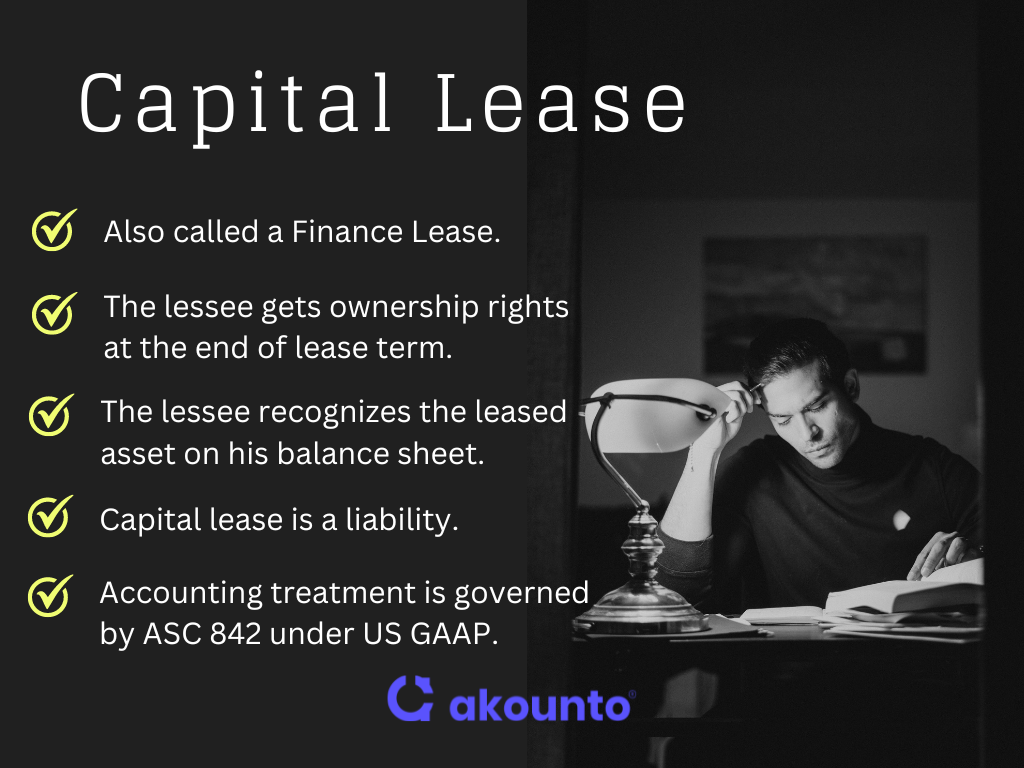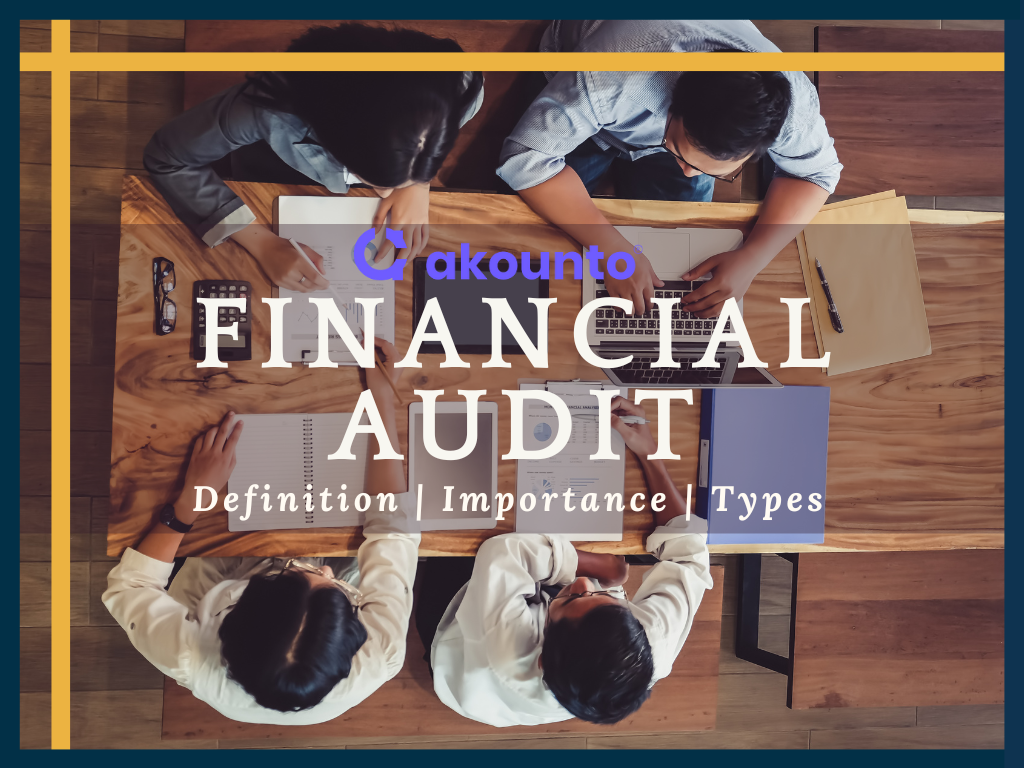What is a Capital Lease?
A capital lease is an agreement where the lessee gets the ownership rights of the leased asset upon completion of the lease period.
The lessee recognizes the asset on his balance sheet right from the beginning of the lease term. The tenure of the lease period is normally designed to overlap with the asset’s useful life.
[ez-toc]
There are two types of leases, operating lease, and capital lease, GAAP accounting standards consider an operating lease as a “true lease” because the asset is returned at the end of the lease tenure.
A capital lease also called a finance lease is considered as a “purchase of asset” under GAAP. In a capital lease, the lessee or tenant gets the ownership of the asset, which is akin to a financed purchase, that is why GAAP does not consider a capital lease as a true lease.

Terminologies to better understand the concept of capital lease:
- Lessee: The lessee is the tenant who has taken the asset (underlying leased asset) on rent. The lessee can be an individual or entity.
- Lessor: The lessor is the original owner of the underlying asset; a lessor can be an individual or entity that grants the lessee the right to use it through a lease agreement.
- Leased Asset: The leased asset or the underlying asset is the property, machinery, etc., that is given on rent (lease payments) from the lessor to the lessee under a lease arrangement.
- Ownership: The legal right to possess, use, and dispose of an asset. The ownership also includes recognizing that asset on the balance sheet.
- Interest Payments: Periodic payments in addition to the principal lease payments made by the lessee to the lessor.
The characteristics of a capital lease are:
- A long-term arrangement
- A non-revokable or non-cancellable
- Similar to a purchase finance
- Similar to a debt arrangement
A capital lease often contrasted with an operating lease, but the basic differences are:
- In a capital lease, the underlying asset is transferred to the lessee, while in an operating lease, the asset is returned to the lessor.
- In a capital lease, the asset is capitalized on the lessee’s balance sheet, while an operating lease is an “off-balance sheet” agreement.
Read the differences between operating leases and capital leases in detail.
Is capital lease a liability?
A capital lease is considered a liability, due to the obligation to make future payments and the specialized nature of capital lease agreements.
When an entity enters into a capital lease agreement, it essentially commits to making periodic lease payments over the lease period. These payments are obligations to fulfill and comprise of principal and interest expense components.
The present value of these future lease payments is recognized on the balance sheet as a “capital lease liability account.”
While both capital and operating leases are lease agreements, only capital leases lead to the recognition of both an asset (the leased item) and a corresponding liability (the obligation to make lease payments) on the lessee’s balance sheet. Operating leases are treated more like rental agreements, with no liability recognition.
ASC 840 and Capital Lease
Earlier ASC 840 under US GAAP gave the guidelines of accounting for leases. Later it was replaced by ASC 842, which modified and built upon ASC 840.
For a lease to be classified as a capital lease under ASC 840, it had to meet at least one of the following criteria:
- The lease transfers ownership of the underlying asset to the lessee by the end of the lease term.
- The lease contains a bargain purchase option, allowing the lessee to purchase the asset at a price significantly lower than its expected fair value at the end of the lease term.
- The lease term is equal to 75% or more of the estimated economic life of the leased asset. (generally referred as 75% Rule).
- The present value of the minimum lease payments amounts to at least 90% of the fair value of the leased asset. (generally referred to as 90% rule for capital lease)
If none of these criteria were met, the lease was classified as an operating lease. The 90% criterion was particularly significant as it emphasized the financial commitment of the lessee, ensuring that substantial long-term obligations were appropriately reflected on the balance sheet.
US GAAP ASC 842: Capital Lease or Finance Lease?
The US Generally Accepted Accounting Principles (GAAP) shifted from ASC 840 to ASC 842.
Under ASC 842, the term “capital lease” has been replaced with “finance lease.” While the nomenclature has changed, the underlying principle remains consistent: leases that transfer substantially all the risks and rewards of ownership to the lessee are classified as finance leases.
The reclassification as a finance lease ensures that the lessee recognizes both the leased asset and the associated lease liability on their balance sheets.
ASC 842 gave the following capital lease criteria:
- Transfer of ownership of the underlying asset to the lessee by the end of the lease term.
- Presence of a bargain purchase option.
- The lease term covering a major part of the remaining economic life of the underlying asset.
- The present value of lease payments equating to or exceeding substantially the fair value of the underlying asset.
While the terminology has evolved, the core accounting treatment for what was formerly known as capital leases remains largely intact under ASC 842.
Example of Capital lease
Consider a manufacturing company, XYZ Corp., that enters into a lease agreement for a specialized machinery. The terms of the finance lease are as follows:
- Lease term: 8 years
- The economic life of the machinery: 10 years
- Present value of minimum lease payments: $900,000
- Fair value of the machinery: $950,000
- Option to purchase machinery at the end of the lease term for $50,000
Analyzing the terms, the lease meets the third criterion of ASC 840 since the lease term (8 years) is 80% of the machinery’s economic life (10 years).
Additionally, the present value of the lease payments ($900,000) is 95% of the machinery’s fair value ($950,000), satisfying the 90% criterion. Given these conditions, XYZ Corp. would classify and account for this lease as a capital lease on its financial statements.
Merits
- Asset Recognition: Finance leases allow the lessee to recognize the leased asset on their balance sheet, providing a clearer picture of the company’s assets.
- Tax Benefits: Depreciation expense on the leased asset can be claimed, potentially reducing taxable income.
- Ownership-Like Rights: Even without the title transfer, the lessee enjoys ownership-like benefits, such as the ability to modify or upgrade the leased asset.
- Fixed Payments: Lease payments are typically fixed, aiding in budgeting and financial planning.
- Bargain Purchase Option: At the end of the lease term, the lessee might have the option to purchase the asset at a price below market value.
- Financial Ratios: Capital leases can improve certain financial ratios by adding both assets and liabilities to the balance sheet.
Demerits
- Balance Sheet Impact: Recognizing both the leased asset and lease liability can increase the company’s reported liabilities, potentially affecting loan covenants or credit ratings.
- Interest Expense: The lessee incurs interest expenses over the lease term, which can impact the income statement.
- Risk of Obsolescence: Given the long-term nature of capital leases, there’s a risk the asset might become obsolete before the lease term ends.
- Ownership Transfer Limitations: While the lessee enjoys many rights of ownership, the actual title might remain with the lessor, limiting certain benefits of full ownership.
- Maintenance Responsibility: The lessee often bears the responsibility for maintenance and repairs, potentially incurring additional costs.
- Higher Initial Costs: Compared to operating leases, capital leases might have higher initial capital lease payments, impacting cash flow.
Conclusion
A capital lease, also known as a finance lease, is an important tool for a small business for asset ownership without an outright purchase. It offers lessees ownership-like benefits while also imposing certain responsibilities.
Visit Akounto’s blogs and learn about the financial concepts to grow and manage your business.




